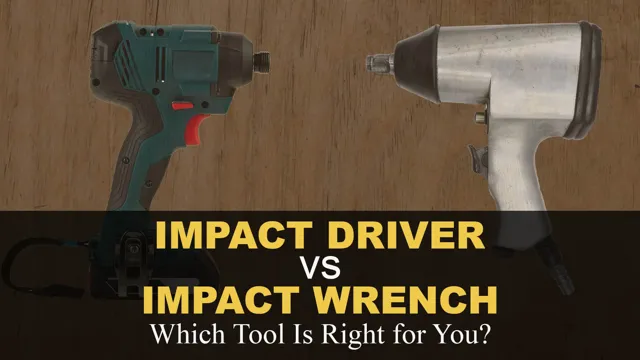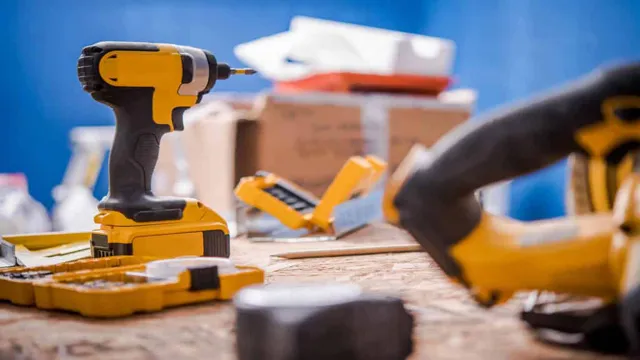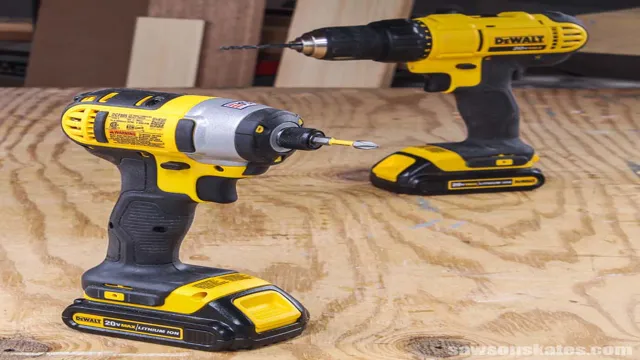Can I Use a Hammer Drill as an Impact Driver? Pros, Cons & Tips
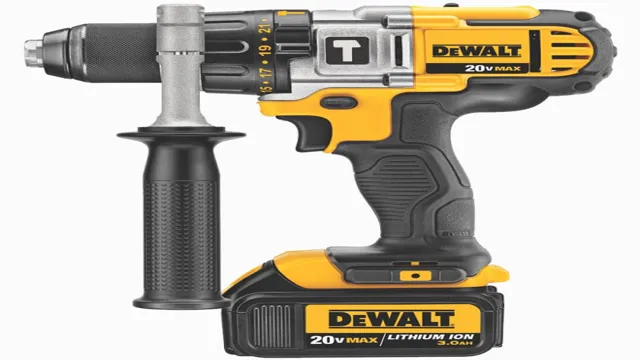
Have you ever found yourself in a DIY project situation, and you thought you had all the right tools, but then realized you needed something else? It can be frustrating, right? One of those situations might be when you were working on a project where you needed to drill holes in masonry and install anchors. You probably got yourself a hammer drill, and it seemed to be working well, but then you realized you needed an impact driver instead. Well, what if I told you that you could use your hammer drill as an impact driver? Yes, you heard that right! In this blog post, we will show you how to use your hammer drill as an impact driver, saving you a trip to the store.
Not only will we guide you through the process, but we will also explain the differences between these two tools so that you can choose the right one for your specific needs. So, sit back, grab your hammer drill, and let’s get started!
Understanding the Difference Between Hammer Drill and Impact Driver
Many people may wonder if they can use a hammer drill as an impact driver. While these tools may look similar, there are some significant differences between the two. A hammer drill is designed for drilling through hard surfaces like concrete or masonry.
It has a function that causes the chuck to move back and forth as it rotates, which helps to break up the surface being drilled. An impact driver, on the other hand, is designed for fastening and loosening bolts, nuts, and screws. It uses a pulsing action to deliver more torque to the fastener, making it easier to drive in or remove.
While a hammer drill can be used to drive in screws, it may not deliver the same amount of torque as an impact driver. If you need to do a lot of heavy-duty screwdriving, it’s best to invest in an impact driver.
How a Hammer Drill Works
A hammer drill and an impact driver may look similar, but they function very differently. A hammer drill uses both rotary and hammering action to drill into hard surfaces like concrete or brick. It works by a hammer mechanism inside the tool which provides an extra boost when force is applied, rapidly striking the drill bit into the surface you are drilling.
On the other hand, an impact driver is used for screwing and unscrewing tasks and comes with a collet to fit hexagonal screwdriver bits. It utilizes rotational force to generate more torque than a standard electric screwdriver. Thus, it is not suitable for drilling holes but can drive long screws and bolts into hard surfaces better than a regular drill driver.
To put it in perspective, hammer drills are like a jackhammer, while impact drivers are more like a power screwdriver. Understanding the difference between the two devices can make your project easier, whether you need to drill into concrete or drive lag bolts into wood.
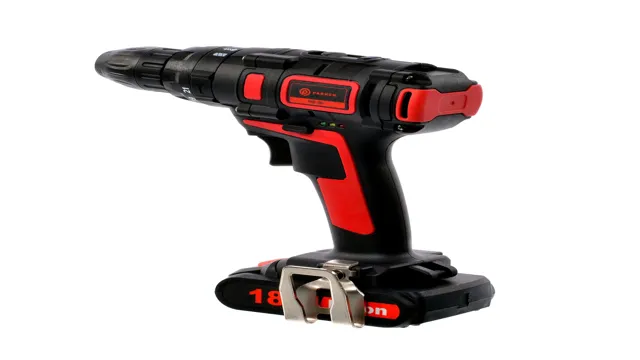
How an Impact Driver Works
When it comes to DIY projects and fixing things around the house, having the right tools makes all the difference. Two popular tools for drilling into surfaces are the hammer drill and impact driver. Although they may look similar, their functions are quite different.
A hammer drill uses a forward-forcing motion combined with a spinning action to drill into hard materials like concrete or brick. On the other hand, an impact driver uses rotational force combined with bursts of torque to drive screws or bolts into surfaces. The key difference between the two is that an impact driver is designed for tasks that require more torque and less speed, making it an excellent choice for heavy-duty work.
So, if you’re looking to take on a home improvement project, consider the hammer drill for drilling into hard materials and the impact driver for fastening screws or bolts into softer materials. By understanding the difference between the two, you’ll be able to choose the right tool for the job, saving you time and effort in the long run.
Can You Use a Hammer Drill as an Impact Driver?
Yes, you can use a hammer drill as an impact driver, but it may not be the most efficient method. Hammer drills are designed to drill through hard materials such as masonry and concrete by rapidly hitting the material with a bit while spinning. Whereas, impact drivers are primarily used for driving screws, bolts and nuts into surfaces.
They apply a quick burst of rotational force to the fastener which is why they are popular for woodworking projects. However, both tools are designed to provide power and speed, so a hammer drill can be used as an impact driver if necessary. But, an impact driver with its specific features such as its mode selector, torque control and better chucking systems is a better tool for the purpose.
So, if you’re working with screws and bolts, switching to an impact driver will be a better option.
The Short Answer
The short answer is no, you cannot use a hammer drill as an impact driver. While these two tools may look similar and serve similar functions, they are designed differently and operate differently. A hammer drill is designed to drill holes into hard surfaces, such as concrete or stone, by utilizing a hammer-like action that applies force to the drill bit as it rotates.
An impact driver, on the other hand, is designed to drive screws into tough materials, such as hardwood or metal, by delivering high levels of rotational force to the screw. Attempting to use a hammer drill as an impact driver could result in damage to both the tool and the material you are working on. It’s always best to use the correct tool for the job to ensure the best results and avoid any potential hazards.
The Long Answer
If you’re wondering whether you can use a hammer drill as an impact driver, the answer is both yes and no. While these two tools might look similar at first glance, they serve very different purposes. A hammer drill is primarily used for drilling into hard surfaces like concrete, brick, and stone.
It has a forward and backward motion that hammers the drill bit into the surface while it’s spinning, making it perfect for tough materials. On the other hand, an impact driver is designed for tightening and loosening screws and bolts. It has a high-torque output that works by delivering bursts of rotational force, making it great for tasks requiring a lot of force.
However, some hammer drills come with a feature that allows you to switch between hammer drill mode and regular drilling mode, which can be helpful for some lighter-duty screw-driving tasks. So, if you only have a hammer drill at your disposal and need to drive some screws, you could potentially use it as a substitute for an impact driver. However, if you plan on frequently doing tasks that require high-torque output, such as building a deck or assembling furniture, it’s probably best to invest in a dedicated impact driver.
Conclusion
In conclusion, while both tools may appear similar and have overlapping capabilities, a hammer drill cannot be used interchangeably with an impact driver. It’s like asking if you can use a spoon to cut a steak – sure, you might make some progress, but it’s not the right tool for the job. Investing in the appropriate tool for your specific project will not only result in a better outcome but will also save you time, effort, and frustration in the long run.
So, put down that hammer drill and pick up that impact driver – your DIY projects will thank you!”
FAQs
What is the difference between a hammer drill and an impact driver?
A hammer drill is designed for drilling into hard materials, while an impact driver is used for driving screws and fasteners.
Can a hammer drill be used as an impact driver?
While technically possible, it is not recommended to use a hammer drill as an impact driver as it can damage both the tool and the fastener.
What are the advantages of using an impact driver over a regular drill?
An impact driver provides increased torque and power, making it better suited for driving long screws and working with dense materials.
Can an impact driver be used for drilling?
While an impact driver can technically be used for drilling, it is not recommended as it does not provide the same level of precision and control as a regular drill.
How do you choose between a hammer drill and an impact driver?
Consider the type of job you will be doing – for drilling into hard materials, a hammer drill is appropriate, while for fastening tasks, an impact driver is preferred.
Can impact drivers be used with any type of fastener?
Impact drivers are best suited for use with screws and lag bolts, but can also work with other types of fasteners with the proper adapter.
What safety precautions should be taken when using an impact driver?
Always wear eye and ear protection, and use two hands while operating the tool. Be sure to read and follow the manufacturer’s instructions for proper use and maintenance.
